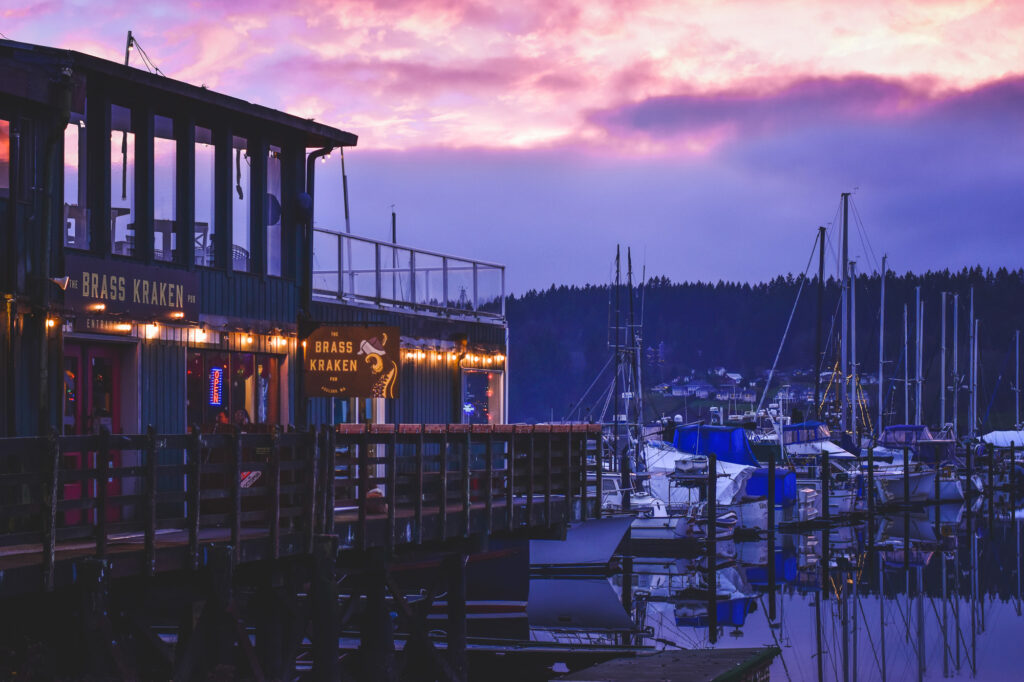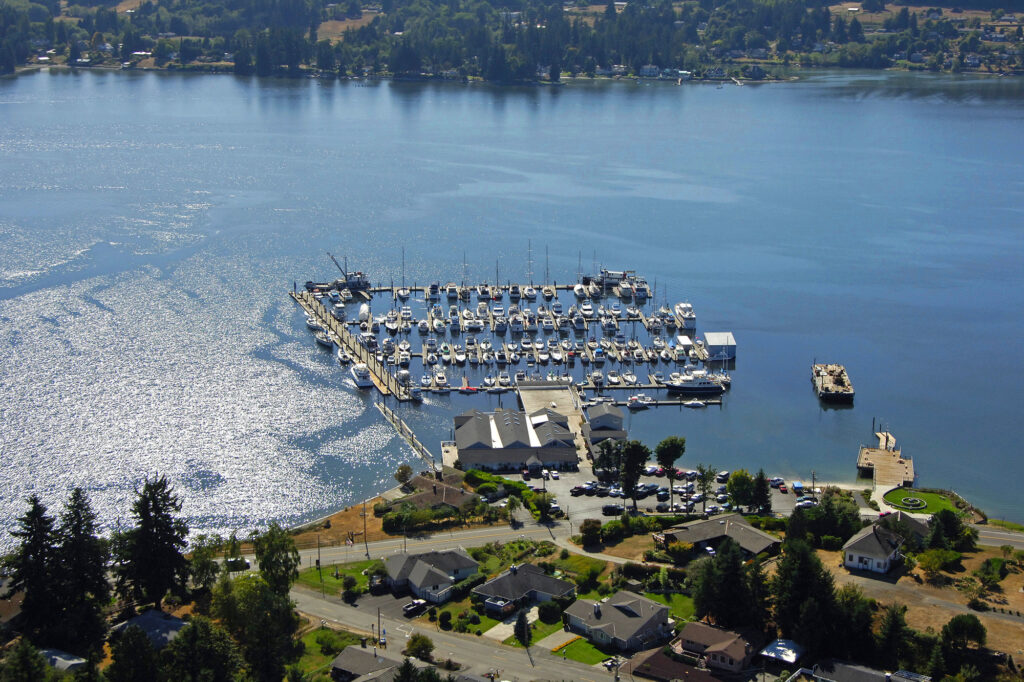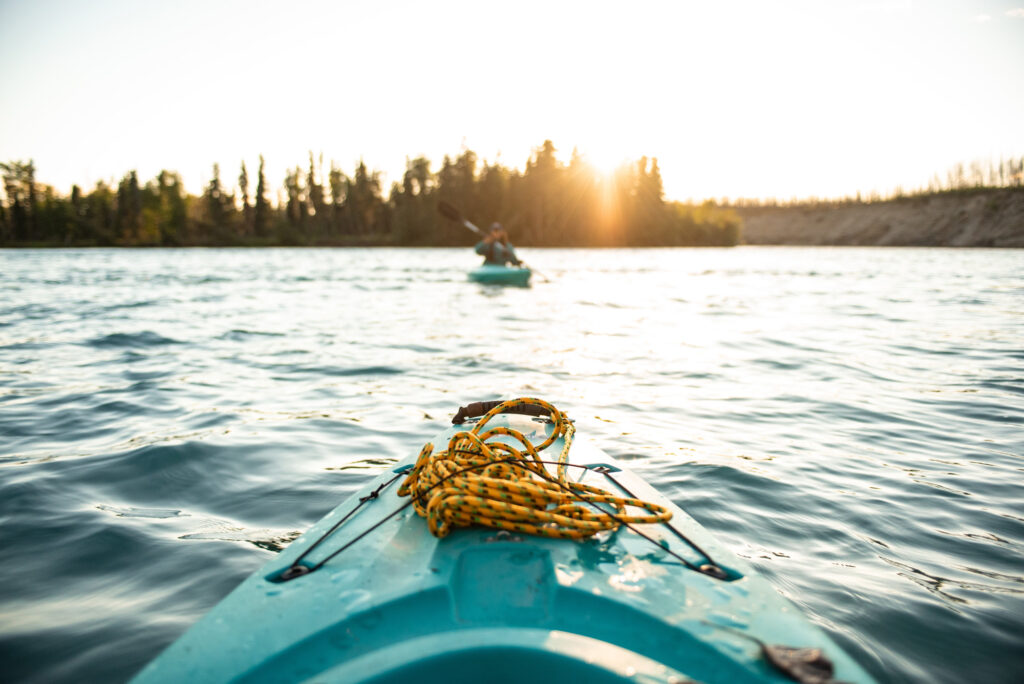By Niki Stojnic

The Kitsap Peninsula Water Trail is a boater’s paradise, a uniquely glorious and varied stretch of saltwater currents. At 371 miles, this is the longest nationally designated water trail on the West Coast—and the first saltwater trail in the United States. Designation gives it status akin to the Pacific Crest Trail and it includes the stretches of waterways, bays, and inlets that flow up into and around Kitsap Peninsula. As the extensive water trail approaches its 10th birthday next year, there are many ways to explore the aquatic path with 200 access points, particularly if you enjoy paddling.
“There are just so many wonderful places to go. You could pick any spot on the map and there’s something interesting,” says John Kuntz, owner of Port Gamble, Washington-based Olympic Outdoor Center and the person who spearheaded getting the Kitsap Peninsula Water Trail (KPWT) on the national map. “There’s always a special place every time of the year: watching the salmon jumping off the mouth of the Skokomish River or watching the orcas in the fall.”
There’s no better time to visit than right now. June brings prime seal pupping time at Liberty Bay, one of the largest seal rookeries in Puget Sound. It can also be a viewing spot for orcas. Kuntz says that one year a pod of orcas came in to do their seal hunting. “So that was pretty spectacular to see, nature in its kind of raw form,” says Kuntz, “orcas hunting seals right in front of our rental dock in Poulsbo.”
Ride the Tide is also a big June draw and a great way to get to know the trails for those who have never explored them. The annual event is a 6-mile guided paddle (in a kayak, canoe, or on a paddleboard) from Dyes Inlet to the Port Orchard waterfront. “We ride the outgoing tide to Port Washington Narrows past Bremerton,” explains Kuntz. “It can reach four to six knots without paddling; that’s just the speed of the water.”
Kuntz’s love and advocacy for the KPWT came when he kayaked the full Kitsap Peninsula coastline in 1996 with a friend. The veteran paddler (he’s been doing so for more than 40 years) immediately understood the need to protect these waterways and coastlines. At the time, he was too busy establishing his nascent company to devote much energy to it; but later, in 2004, Kuntz got involved with the North Kitsap Trails Association around some timberland in Port Gamble that was going to become a county park. He began to formulate a water trail plan and finding others interested in the idea. The rest is history.
“The chance for us early on, to secure these sites and then make it known that they’re special, really I think set the tone for the number of sites we have today.”
While there are popular areas along the trails, such as Dyes Inlet or Liberty Bay, Kuntz says it’s far more likely that you’ll be touring in relative serenity most places you go. “Once you get outside these areas, you may not even see another kayaker. You’re paddling coastline where it’s just you and your friends, stopping on some beach that looks inviting and is part of the trail, and making a day of it.”
Kuntz is very happy that the work he and others put into getting the KPWT recognized has helped turn it into a destination for boaters and land-based recreationers alike over nearly a decade. “My satisfaction in creating the trail was to see people use it. And to really care about it, so that they can save it and protect it environmentally, as well as in other ways.”

Where to Go
Sites on the KPWT can generally be accessed by beachable craft, but there are areas with moorage from which you can paddle around or stop and sightsee. The Washington Water Trails Association (wwta.org/kitsap-peninsula-water-trail/) has 12 routes you can look at, and at the Kitsap Peninsula Water Trails interactive map (kitsappeninsulawatertrails.com/maps/) has 84 access locations with information on each site’s amenities. Here are a few spots to inspire your planning:
Catch views of the Cascades and Olympics at popular Fay Bainbridge Park, which boasts 1,420 feet of saltwater shoreline on northeast Bainbridge Island; Illahee State Park features the last stand of old-growth timber in Kitsap County and one of the largest yew trees in the U.S. Dosewallips State Park, along the Hood Canal and Dosewallips River, is a delight for birders and beach explorers—go clamming or fishing here, too. Foulweather Bluff Preserve, one of the northernmost points of the KPWT, is a haven for wildlife.
Prefer an overnight or two? Go camping at Jarrell Cove State Park on Harstine Island, a marine camping park where you can hike trails, fish, and dive. It has dock and moorage space plus moorage buoys. The 475-acre Blake Island Marine State Park has 1,500 feet of moorage dock and 24 mooring buoys, plus views of the Seattle skyline to the east and the Olympics to the west as a backdrop for your camp or wildlife-seeking adventure. Go birding (and shellfish harvesting January through May) at Wolfe Property State Park, a secluded and undeveloped campsite.
Be a tourist at the many fantastic towns that dot the water trail coastline. Take a walk through National Historic Landmark lumber town Port Gamble on Hood Canal (also home base for Olympic Outdoor Center), with shops and great eats, such as Butcher & Baker Provisions’ fantastic fried chicken sandwich with pimento cheese. On Liberty Bay, the Norway of the Pacific Northwest aka Poulsbo, offers a different side of PNW history—and lots of places to stroll, picnic in the park, or have lunch with marina views, such as at the Brass Kraken; or dig into the area’s heritage at the Maritime Museum.
Cruise by Lakebay Marina. Last year, the Recreation Boating Association of Washington began the process of restoration of the property, which includes marina facilities and 2.8 acres of uplands and tidelands, with the intent to return the restored property to the Washington State Department of Natural Resources for management.

More to Do
Bioluminescence Tours: Starting June 8, try a bioluminescence tour through Olympic Outdoor Center. You’ll paddle through Port Gamble Bay at night to see the colorful algae glow up the water. Sign up to go under a full moon or on a non-full moon night (olympicoutdoorcenter.com).
Ride the Tide: June 17, join the 6-mile guided paddle in a kayak, canoe, or on a paddleboard (bring your own or rent) from Dyes Inlet to the Port Orchard waterfront. It’s a great way to get to know the water trail if it’s new to you (info can also be at olympicoutdoorcenter.com).
Port Orchard Farmers’ Market: Cruise up to this sweet marina market for local produce and meats, plants, crafts, and more, every Saturday April through October (pofarmersmarket.com).
Fathoms O’ Fun Fireworks and Festival: Watch fireworks over Sinclair Inlet from water or land on the Saturday before July 4, as well as other fun Independence Day events in Port Orchard (fathomsofun.org).
>> For more details on the many sites to see within the Kitsap Peninsula Water Trail System, information on lodging and moorage options, and tips on planning your own route, go to: kitsappeninsulawatertrails.com.



1 comment
What a terrific article, I really enjoyed reading it!
Our marina is currently under construction with a Breakwater Replacement Project. This phase of the construction is due to be completed until perhaps fall. This is a huge project and I am contacting you on behalf of of Port Manager to see if you might have an interest in writing an article about this?
Thank you,
Jannese Hunt